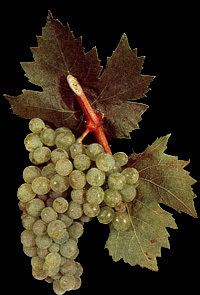Color of berry skin Blanc Sweetness of resulting wine Dry or sweet | Species Vitis vinifera Wine color White wine Rank Cultivar | |
 | ||
Similar Pamid, Misket Cherven, Mavrud, Common Grape Vine, Kadarka | ||
Dimiat (Bulgarian: димят; also romanized as Dimyat or Dimjat) is a white Bulgarian wine grape. It is one of Bulgaria's most widely planted white grape varieties, second only to Rkatsiteli. Wines made from this variety are noted for their perfume aromas. While some ampelographers believe that the variety is indigenous to Bulgaria, legends have developed around Dimiat being named after a town in the Nile Delta and was brought back to Europe by Crusaders in the Middle Ages.
Contents
History
The exact origins of the Dimiat grape are unknown, with some ampelographers believing the vine to be native to the Bulgaria area. Recent DNA typing has shown it to be a crossing of Gouais Blanc (Weißer Heunisch) with another, unidentified grape variety. Gouais is a parent of several older European grape varieties. One alternative hypothesis, which is highly improbable given the Gouais parentage, is the legendary tale that the grape was native to the Nile Delta valley (where today there is an Egyptian town with a similar name, Damietta) and was brought back to Thrace by Christian Crusaders.
It is likely that the grape crossed with Riesling to produce the pink-skinned Misket Varnenski grape variety.
Wine regions
The Dimiat grape is almost exclusively grown in Bulgaria with vineyards mostly in the south and eastern parts of the country. It is most widely planted in the Chirpan, Preslav and Shumen regions around the Black Sea. Other Bulgarian wine regions growing some Dimiat include Haskovo and Varna. After Rkatsiteli, it is the second most widely planted white grape variety with over 23,720 acres (9,600 hectares) planted in 2005.
Outside of Bulgaria, there is small plantings of the variety in the neighboring Greek wine region of Thraki (part of what was the historical region of Thrace). Here Dimiat is known under its synonym of Zoumiatiko.
Viticulture and winemaking
The Dimiat vine is characterized by the large size of the individual grape berries with the potential for high yields if not kept in check. During veraison, the berries turn copper yellow. In addition to being used in the production of table wines, Dimiat is often distilled to produce Bulgarian brandy (rakia).
Wines
Dimiat wines are usually light bodied and very aromatic. The wines are usually made with some level of sweetness ranging from off-dry to very sweet. In Bulgaria, some dessert wines are made from Dimiat. The wine is often served very chilled and is usually consumed young, without much aging.
Synonyms
The various synonyms of Dimiat include-Ahorntraube, Beglerdia, Beglezsia, Bekaszaju, Bekaszölö, Belezsi, Belina, Belina krupna, Belogollandskii, Belogollanskii, Bemena, Bois Jaune, Damiat, Damjat, Damjat bial, Debela lipovina, Dertonia, Dertonija, Dertonilia, Dimiate, Dimjat, Drobna Lipovscina, Dymiat, Fehér Szemendriai, Galan, Koplik, Krupna belina, Laschka, Laska belina, Mana Kuki, Misket de Silven, Misket Slivenski, Nagyvögü, Pamid, Pamit, Parmac, Plovdina, Plovdina esküska, Plovdina eskulska, Saricibuk, Plovdiska, Podbelec, Podbeuz, Radoviska plovdina, Roscara, Rosiora, Saratchobok, Saridzibuk, Semendra, Semendria, Semendru, Senederevka, Smederevka, Smederevka bianca, Smederevka bijela, Smederevka white, Szemendriai féher, Szemendriai Zöld, Szemendrianer, Tök szöllö, Töksölö, Tökszölö, Töröklugas, Wippacher, Wippacher ahornblättrig, Yapalaki, Zarja, Zmedervka, Zoumiatico, Zoumiatis, Zumjat, Zumjatiko and Zumyat.
